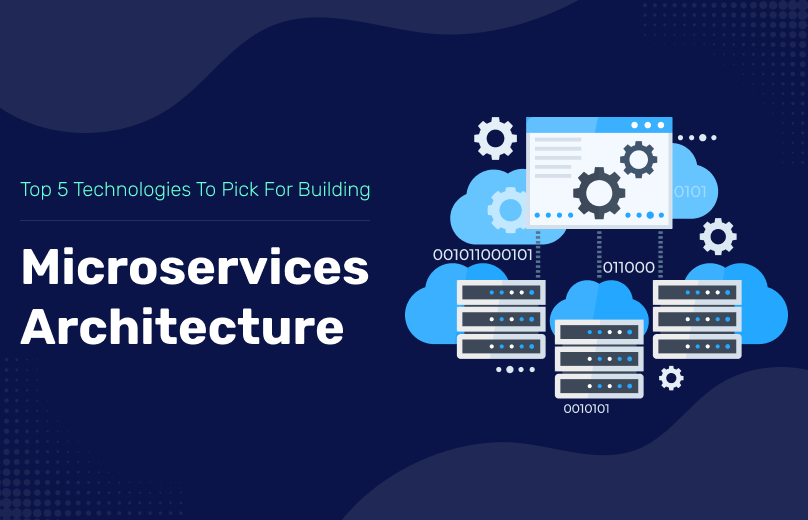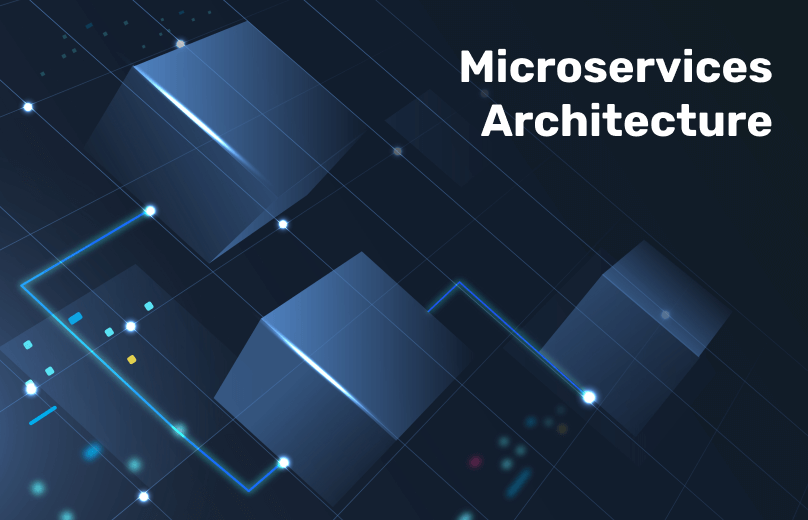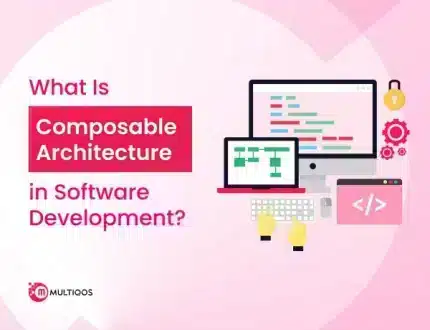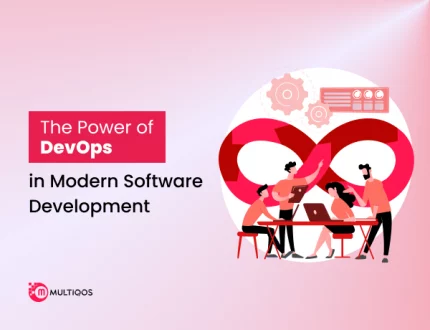Top 5 Technologies to Pick for Building Microservices Architecture Development

Table of Contents
- What Is Microservices Architecture?
- Reasons To Migrate To Microservices Architecture
- Benefits Of Microservices
- Criteria For Choosing A Technology For Microservices
- Technologies That Make Microservices Architecture Development Easier
- What To Consider Before Adopting Microservices Architecture
- Best Languages For Microservices
- Wrapping Out
One of the most significant software architectural trends in microservices development. An application is organized as a series of loosely connected services in a microservices architecture. A microservice is a self-contained part of the business with a well-defined interface. Microservices make it easier to maintain an application because they are composed of separately developed components.
Companies and businesses are aspiring to implement the Microservice architecture, on the other hand, face the most difficulty in selecting the appropriate tools and technology. Let us delve deeper into the 5 best technologies businesses and companies and pick for building microservices architecture development.
What Is Microservices Architecture?
Microservices architecture can be defined as a development paradigm that allows you to break down a single program into multiple smaller services. Each of them operates in its processes and interacts through lightweight mechanisms. Microservices are built around business functions and can be deployed independently using an automated deployment method.
Microservices Architecture requires very little management of these services, which are written in various programming languages and use a variety of data storage systems. The goal of microservices architecture is to simplify the deployment process and produce cloud-ready, high-end software quickly. You may create an application that is simpler to scale, alter, and deploy by breaking it into smaller parts.
Reasons To Migrate To Microservices Architecture
While it cannot be negated that microservices provide several advantages for larger products for a large number of developers engaged in them, monoliths are frequently used for smaller projects. Having a single code base puts the monoliths in a better position where they are less expensive to develop and launch. Thus, the step of migration should be a well-thought option for the business where it should take account of the demands and requirements of the company.
Some of the reasons why the businesses need to migrate to microservice architecture are:
- It is difficult to decipher the intricacy of a vast program in monolithic architecture. It is also complicated to handle the monolithic code, which is one of the primary reasons for migrating to a more advanced structure.
- Separate independent developer teams can use numerous methods to work on a similar application in the case of microservice architecture. In monolithic, the individual components of a program are not independent at the code level; however, they are developed collectively as one system which works in contrast to the microservice structure, which offers a more agile and adaptable approach.
- Productivity and Scalability issues are the most prevalent factors for businesses to shift to microservices. Expanding projects necessitate additional developers, thus enabling them to focus on a particular application service, making things a tad simpler.
- The developer team has accessibility to the same code base if they’re using monolithic architecture. In this instance, even the tiniest modification can interrupt team communication and cause modification to the entire application. The requirement for repeated testing is increasing to eliminate conflicts, which slows down the release process as a whole and reduces departmental output.
- To understand the effect of changes, applications require considerable manual testing.
- The start-up time can be substantially slowed by an extensive application with a monolithic design.
- However, microservices solve all of these issues. Where CI/CD pipelines are simple to integrate, they enable immediate releases. Thus, thousands of deployments can take place per day. At the same time, the application continues to function normally, as it is made up of numerous little components.
Benefits Of Microservices
There are a plethora of advantages that have been tempting companies to shift from the regular monolithic structure to the advanced microservices.
- Scalability: Dealing with microservices makes scaling up and down your program a breeze because the architecture is built on small, individually versioned components.
- Extensibility: Microservices are grouped according to their business skills. They give applications the ability to add new features, interfaces, input types, devices, and others. Furthermore, businesses would be able to add more features and functionalities to the system when new technologies become mainstream.
- Small Components: It is simple for developers to develop and maintain the program because it is broken down into smaller components.
- Easy Maintainability: Every service in microservices can be deployed, replaced, and scaled independently. Developers can operate more autonomously, formulating and implementing technical decisions faster. Microservices also have the advantage of automated testing and deployment.
- Unaffected By Failure: The failure of a single module doesn’t affect the rest part or even the entire application.
Criteria For Choosing A Technology For Microservices
One might use microservices to create a dependable platform for expanding your business whilst benefiting language variety. While different languages and technologies can be utilized in a wide array of services, this doesn’t necessarily indicate that they can be effective. The microservices design has a lot of operational costs; thus, layering on various programming languages can dramatically increase that overhead. To mitigate this, standardize your microservices technology platform by selecting a programming language that meets your business requirements. The following are the criteria for evaluating a programming language for the construction of microservice architecture:
- Highly perceptible
- Automation is supported.
- Customer Priority
- Designed with the business domain in priority
- Independent deployment
- Component decentralization
- Continuous integration is encouraged
Also Read : How to Find Your Iphone Serial Number, UDID, or Other Important Information
Technologies That Make Microservices Architecture Development Easier
Microservices can be deployed using a variety of tools, platforms, and versions and some of which are:
- Docker and Kubernetes: Docker is a container management technique that aids in the development, testing, and deployment of software systems as self-contained packages within a container. Kubernetes, on the other hand, is a technology designed to automate the manual labor involved in setting up and maintaining containerized applications. Docker makes it simple to deploy software since you have to use Dockerfiles to deploy Docker images. Further, it works with various operating systems, has several available plugins to enhance its capabilities, and can be integrated with various complex tools and services.
- Prometheus: Prometheus is a comprehensive monitoring and alarm system for many dynamic application topologies with numerous nodes. This software executes multidimensional data using key-value labels and includes a database server and scrapes. Prometheus is a simple and quick tool that analyzes data based on labels.
- Consul: In Consul, the microservices can communicate with others because of Consul technology. This has a lot of unique features. Consul can also be used with different technologies thanks to the DNS interface and the Consul Template.
- Redis: One of Redis’ many advantages is that it may be used in a broad variety of contexts. It’s a faultless NoSQL database that allows elastic data structures and speedy replies to solve complex coding challenges with simple instructions. Redis supports Streams, Hashes, and other forms of values in addition to a core data model.
- REST: REST, also called Representational State Transfer, is a communication protocol that allows microservices to be used for interaction or communication with others. The REST microservice can communicate directly via HTTP using this architectural design approach. It works with standard formats like JSON, XML, and HTML for responses and queries.
What To Consider Before Adopting Microservices Architecture
- Inter-Service Communication: To execute the operation in a microservices architecture, services connect concurrently or sequentially. An inter-service communications platform orchestrates this communication.
- Data Consistency: Since each microservice has its own personal database, it can be difficult to ensure data consistency throughout transactions that traverse many services.
- Security: Both at rest or in transit, encryption technologies, as well as strong authentication and authorization systems, are available to assure data security. Furthermore, APIs must be protected by an API Gateway to prevent unauthorized users from utilizing a token to get access.
- Monitoring: The application’s efficiency is ensured by employing distributed transaction tracking and health check APIs to monitor the system. Teams may generate visualizations for key indicators, acquire past data for performance patterns, and receive notifications when issues develop with the correct surveillance and monitoring.
- Quality Assurance: Microservices manage queries by transferring messages between services, which ensures quality. With an escalation in services, automated testing is essential to verify that all exchanges and communications, especially unit tests, integration tests, contract tests component tests, are thoroughly verified.
Best Languages for Microservices
Here is a list of the best language for microservices are:
- Java: Java microservices framework is a popular programming language amongst developers because it is reliable and readable. Using Java to develop microservices architecture is more advantageous. Developing Java microservices is a simple matter of understanding the solution. Its simple annotation syntax makes creating microservices architecture a breeze. Furthermore, Java is an excellent choice because it includes a user interface, connectivity to back-end resources, and model components.
- Golang: Go was first introduced by Google in 2009. Golang is the term given to this language because of the domain name. In a microservices architecture, the Golang microservices framework is well-known for its API support and concurrent capabilities. Its simultaneous capability also boosts the productivity of multiple devices. Further, one can build microservices easily since its feature facilitates the entire Golang Development.
- Python: Microservices framework python is a high-level programming language that aggressively encourages technology integration. In contrast to other programming languages and frameworks, the python microservices framework allows for quick and easy prototyping. This means that it is the best option for developers. Python is entirely compatible with existing languages like PHP and ASP.
- Node JS: Node JS has become the go-to platform for organisations and businesses looking to implement microservices over the years. Because Node JS is based on the V8 runtime, microservices are possible. Also, it has progressed greatly through time. Node.js is a popular microservices framework used by developers all around the world. Web app development with Node JS is also easy. Businesses depend on microservices Node.js for high performance, cheaper costs, increased productivity, and pleased developers.
- .Net: For Microservices: .NET is an excellent cross-platform solution. It enables you to work with a dependable and well-established language that is supported and maintained by Microsoft. Its built-in Docker containers aid in developing microservices. .NET microservices may be readily integrated with applications developed in Node.JS, Java, or any other language. This facilitates the transition to.NET core technologies.
Also Read : How to Build & Launch your own NFT Marketplace and How Much Does It Cost?
Wrapping Out
Alongside large corporations, numerous small and medium-sized businesses and enterprises are shifting towards developing complex applications, intending to migrate from monolithic systems to a single independent Microservice architecture. Choosing the right technology and languages for your microservices is difficult. After all, the tool you choose to create distinct app pieces determines the technology you use. Furthermore, the knowledge of your employees is crucial. If you’ve decided to go the microservices route, you’ll need to find a trustworthy partner to help you accomplish your project.
Contact us right away if you’re considering using microservices and need a dependable technology partner. Our highly qualified team is skilled at creating custom development that meets your specific needs.
Let’s Create Big Stories Together
Mobile is in our nerves. We don’t just build apps, we create brand. Choosing us will be your best decision.
Get In Touch





